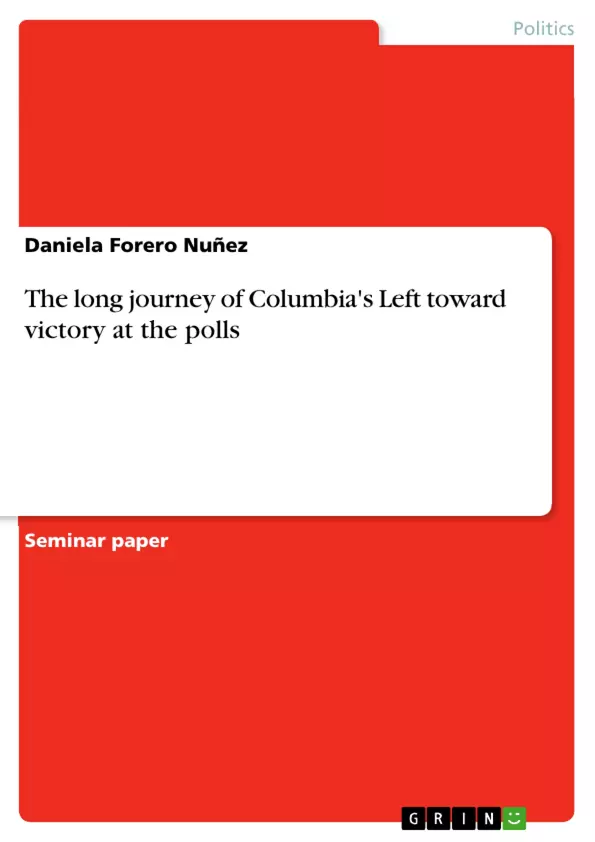The present paper examines the factors that might explain Colombia’s comparatively late political Left Turn. To this end, it explores the historic conditions that hindered the consolidation of a leftist political party or coalition with broad electoral support until the foundation of the Historic Pact for Colombia. Moreover, it draws attention to the recent social, political and economic developments that have fostered the expansion of this left-wing coalition yet considering that the efforts to cement a leftist political alternative date back to the last century.
Between 2005 and 2008, the share of Latin American presidents from a right-wing party fell to 33%, compared to 64% in the early 1990s. By 2009, more than two-thirds of the countries in the region had a president from a left- or center-left party. Despite common sociopolitical and economic developments with its neighboring countries, Colombia elected a leftist president – for the first time in its modern history – only this year.
Inhaltsverzeichnis (Table of Contents)
- 1. Introduction
- 2. Latin America's Left Turn: common economic and sociopolitical developments in regional comparison
- 2.1 Defining the Latin American "Left"
- 2.2 Economic factors: The unraveling of the neoliberal consensus and the search for a more equitable growth model
- 2.3 Sociopolitical factors: From narrow political openness toward the institutionalization of electoral competition
- 3. Particularities of Colombia: The Colombian Internal Armed Conflict
- 3.1 The narrative of the “internal enemy\" as a pretext for political violence and exclusion
- 3.2 The challenges of consolidating a unified democratic left in the 21st century
- 3.3 Alvaro Uribe's political project: The Democratic Security Policy (DSP).
- 4. Empirical evaluation: Understanding the timing of Colombia's late Left Turn
- 5. Conclusion
Zielsetzung und Themenschwerpunkte (Objectives and Key Themes)
This paper aims to explain Colombia's late Left Turn, considering the country's delayed election of a leftist president compared to other Latin American nations. It analyzes historical and recent factors that contributed to the rise of a leftist political force in Colombia, examining the context of the Colombian internal armed conflict and the emergence of the Historic Pact for Colombia. The paper draws upon the theoretical framework of the Latin American Left Turn, using research from governmental and non-governmental institutions, as well as economic and social indicators to provide a comprehensive understanding of the Colombian case.
- The historical context of the Colombian internal armed conflict and its influence on leftist political development
- The emergence and consolidation of the Historic Pact for Colombia as a leftist political force
- The impact of economic factors, such as inequality and the unraveling of the neoliberal consensus, on the rise of the Left in Colombia
- The role of social and political movements in fostering the expansion of leftist support in Colombia
- The significance of the Colombian case in understanding the broader Latin American Left Turn
Zusammenfassung der Kapitel (Chapter Summaries)
- Chapter 1 introduces the topic of Colombia's late Left Turn and outlines the research objectives. It discusses the historical context of the Latin American Left Turn and its theoretical framework, emphasizing the role of socioeconomic factors and the challenges faced by leftist movements in consolidating their power.
- Chapter 2 delves into the common economic and sociopolitical developments that have characterized the Latin American Left Turn. It defines the "Left" in a regional context, highlighting the emphasis on social and economic equality, and examines the factors that have contributed to the rise of leftist movements, including the unraveling of the neoliberal consensus and the need for more equitable growth models.
- Chapter 3 focuses on the specificities of the Colombian context, particularly the Colombian Internal Armed Conflict and its impact on leftist political development. It analyzes the narrative of the "internal enemy," the challenges of consolidating a unified democratic left, and the impact of Alvaro Uribe's political project, the Democratic Security Policy.
Schlüsselwörter (Keywords)
This paper explores the Latin American Left Turn, focusing on the particularities of Colombia's late political shift toward the Left. The key themes include the Colombian Internal Armed Conflict, the emergence of the Historic Pact for Colombia, economic factors like inequality and the neoliberal consensus, sociopolitical factors like the consolidation of a unified democratic left, and the broader theoretical framework of the Latin American Left Turn. The paper aims to provide a comprehensive understanding of the factors that contributed to Colombia's late Left Turn, examining the country's unique historical and contemporary developments.
- Quote paper
- Daniela Forero Nuñez (Author), 2022, The long journey of Columbia's Left toward victory at the polls, Munich, GRIN Verlag, https://www.hausarbeiten.de/document/1330359


